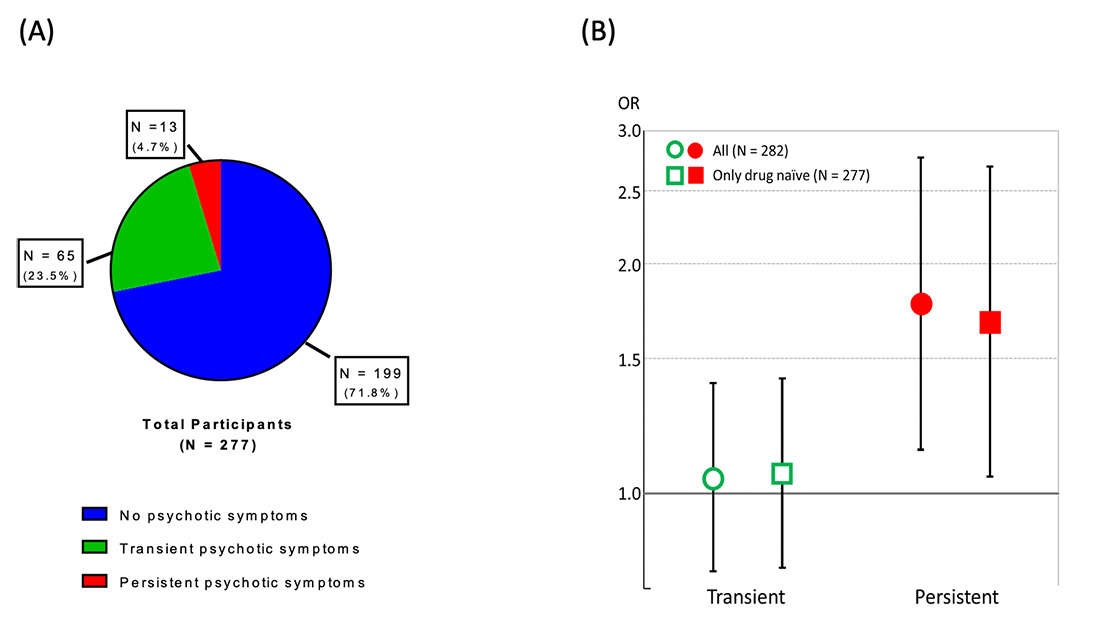Advanced glycation end products (AGEs) play a key role in the pathophysiology of chronic schizophrenia. However, the association between AGEs and psychotic symptoms among drug-naïve adolescents remains unclear. A total of 277 community-dwelling adolescents aged 13 years were analyzed in a prospective cohort study. Multinomial logistic regression analysis adjusted for confounders revealed that baseline AGEs might predict the risk of persistent psychotic symptoms, which indicated its involvement in the pathophysiology of early psychosis.

Case control studies have suggested that advanced glycation end products play a key role in the pathophysiology of chronic schizophrenia. However, the longitudinal association between advanced glycation end products and psychotic symptoms among drug-naïve adolescents remains unclear
This study examined whether advanced glycation end products could predict the trajectory of psychotic symptoms in drug-naïve adolescents using data from prospective population-based biomarker subsample study of the Tokyo Teen Cohort. A total of 277 community-dwelling adolescents aged 13 years without antipsychotic medication were analyzed. Fingertip advanced glycation end products were measured in adolescents using non-invasive technology that can be used quickly. The trajectory of psychotic symptoms in a 12-month follow-up was assessed by experienced psychiatrists using a semi-structured interview. Longitudinal profiles of psychotic symptoms across the two time points (baseline, follow-up) were defined as follows:
Of the 277 participants, 13 (4.7%) experienced persistent psychotic symptoms (psychotic symptoms at baseline and follow-up), 65 (23.5%) experienced transient psychotic symptoms (psychotic symptoms at baseline or follow-up), and 199 (71.8%) did not have psychotic symptoms (Figure A). Multinomial logistic regression analysis adjusted for age and sex revealed that baseline fingertip advanced glycation end products might predict the risk of persistent psychotic symptoms (odds ratio = 1.68; 95% confidence interval, 1.05–2.69; P = 0.03, Figure B).
Altogether, fingertip advanced glycation end products potentially predicted the trajectory of psychotic symptoms among drug-naive adolescents, which indicated its involvement in the pathophysiology of early psychosis. Noninvasive and easy operation of the measurement may be widely accepted in clinical and community settings, and further studies are required to identify strategies to reduce adolescent advanced glycation end products, which may contribute to preventing the onset of psychosis.

The result overviews
The results of this study are summarized (A-B). Among 277 drug-naïve adolescents, 13 (4.7%) were assessed as persistent psychotic symptoms. Among the rest of the sample, 199 (71.8 %) and 65 (23.5 %) participants had no psychotic symptoms and transient psychotic symptoms, respectively (A). Multinomial logistic regression analysis adjusted for age and sex demonstrated that ORs for persistent and transient psychotic symptoms compared with those for no psychotic symptoms were 1.78 (95% CI, 1.14–2.76, P = 0.011) and 1.05 (95% CI, 0.79–1.40, P = 0.73), respectively, for a 1 SD increase in fingertip AGEs. The significance and magnitude of effect size for persistent psychotic symptoms remained even after excluding five participants who were using antipsychotic medications (OR, 1.68; 95% CI, 1.05–2.69; P = 0.03) (B). Error bars indicate the 95% confidence interval.